Table of Contents
Are you aiming for rounder, firmer, and stronger glutes? If so, then hip thrusts should definitely be a staple in your workout regimen. When it comes to toning and sculpting the glutes, they can outshine squats, deadlifts, or lunges in certain respects. However, mastering the proper technique is key to reaping their benefits and steering clear of common mistakes. We’ll delve into all of this in today’s article.
While at the gym, you’ve probably observed both men and women seated on the floor with their backs against a bench, a barbell loaded at hip level, getting ready for the hip thrust, which has emerged as the go-to exercise for glutes in recent years. This surge in popularity is largely credited to trainer Bret Contreras, known as The Glute Guy, who is arguably the world’s foremost authority on glute training. He highlights the uniqueness of the hip thrust in its ability to achieve full hip extension, resulting in a significant shortening of the glute muscle fibres. This intense activation and strengthening make the hip thrust one of the most effective exercises for sculpting round and strong glutes. [1]
What Is a Hip Thrust?
There’s no magic pill for growing your glutes, which is why there’s the hip thrust. It’s an exercise where you lean your upper back against a bench, low box, or other elevated platform, with your feet planted on the ground and knees bent. You start in a seated position on the floor and then, by contracting your glutes, lift your pelvis upward until your hips reach full extension. In the top position, your torso is parallel to the ground. It’s this position that allows for maximum engagement of the gluteal muscles.
What is the difference between the glute bridge and the hip thrust?
Many people confuse the hip thrust with the glute bridge. Both are excellent for working the glutes, but there are differences between them. While during the hip thrust, your upper body is elevated, during the glute bridge, you exercise with your back on a mat. They also differ in that the glute bridge is more commonly used as an activation exercise with just body weight, while the hip thrust is more popular with added resistance. You can combine them in your workout routine. [4]
If you’re interested in learning how to properly do the glute bridge and its most effective variations, you’ll find everything in the article: Glute Bridge: Top 10 Variations for a Firmer and Rounder Butt
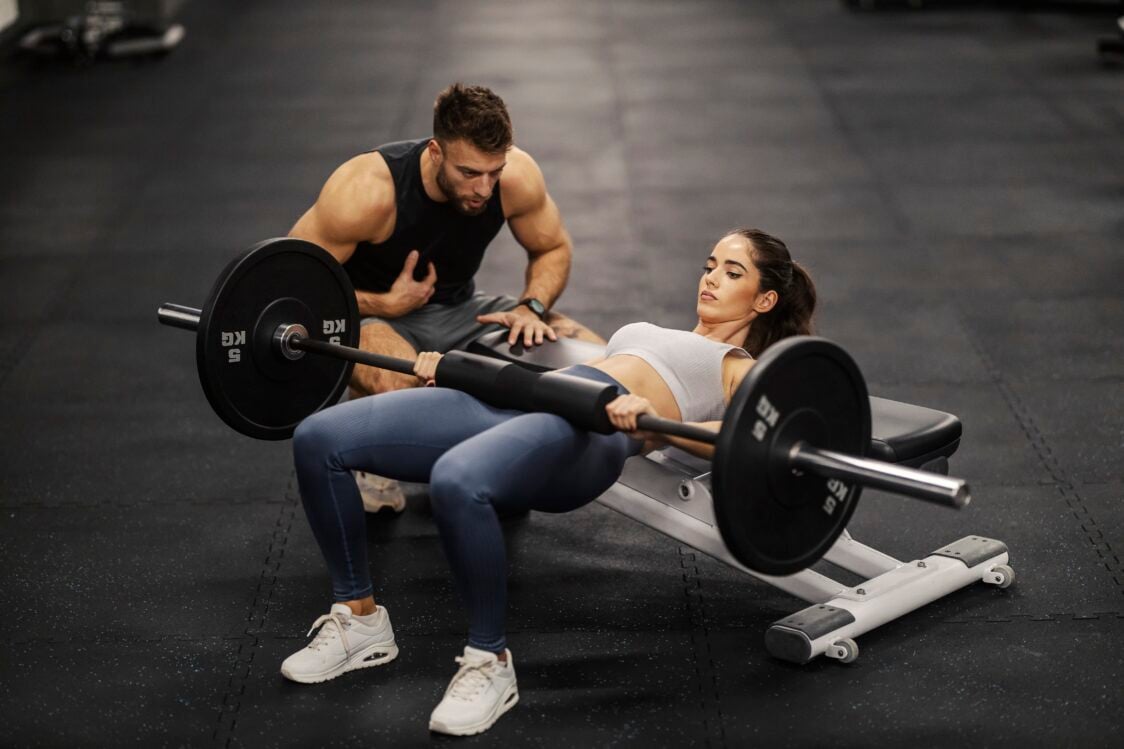
Why Do Hip Thrusts? 5 Greatest Benefits
Hip thrust isn’t just an exercise for women longing for a perfect booty. Men will also appreciate its positive impact on muscle and strength development, as well as overall athletic performance.
1. They are suitable for both begginers and advanced individuals
Beginners can manage the basic variation of the hip thrust with just their body weight. This exercise isn’t as technically demanding as, for example, squats. Advanced individuals can increase the difficulty by adding weight such as a barbell, kettlebell, or resistance band. Moreover, hip thrusts are less limited by one’s own mobility (range of motion in the joints) compared to squats.
2. They help develop strong glutes
Hip thrust exercises intensely engage the gluteus minimus, medius, and maximus muscles, resulting in comprehensive strengthening of the gluteal muscles. This leads to a firmer, rounder, and stronger butt. Such improvements are not only beneficial for other exercises like squats or deadlifts, but also enhance performance in various sports and everyday activities.
In addition to engaging the gluteal muscles, you’ll also involve the hamstring muscles (back of the thighs), quadriceps (front of the thighs), and thigh adductors (inner thighs) to a lesser extent. This makes it an effective exercise for the lower body. [4]
Squats vs Hip Thrusts: Which exercise is better for glutes according to studies?
The squat is considered the king of lower body exercises. Therefore, many bodybuilders and fitness enthusiasts often wonder whether it’s worth doing hip thrusts as well, given that squats are also an effective exercise for the glutes. Fortunately, experts have started to address this topic, providing scientific evidence regarding the effectiveness of both exercises. [5]
According to studies, both squats and hip thrusts are effective exercises for building gluteal muscles. However, when focusing on building and rounding the buttocks, hip thrusts may be a slightly better choice. They can activate the gluteal muscles (especially the gluteus maximus) with greater intensity. On the other hand, squats target the muscles on the front of the thighs and the adductors (inner thigh muscles). Therefore, if you want to reap the benefits of both worlds, incorporate both exercises into your training plan.
You can learn all about the benefits, proper technique, and variations of squats in the article: Squats: Benefits, Proper Execution and the Most Effective Variations for Both Home and the Gym
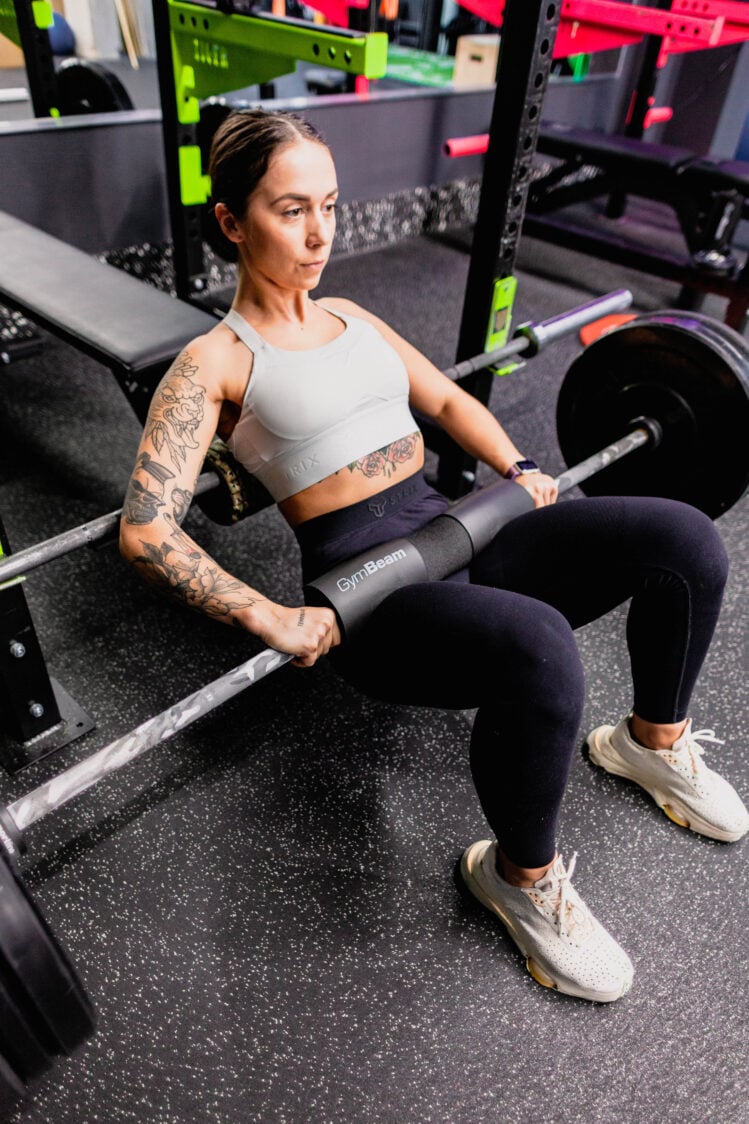
3. They can help achieve a sexy butt
If your goal is to have a firm and round butt, then definitely consider incorporating hip thrusts into your workout. Besides coach Bret Contreras, many fitness competitors and influencers swear by it, such as Kayla Itsines and Michelle Lewin. It’s an effective exercise for increasing butt size, during which you’ll be lifting the load (barbell with plates, dumbbell) primarily with your gluteal muscles. When you challenge them with sufficient weight, they’ll really feel the burn. And that’s when adaptation mechanisms kick in, like growth and strengthening. Over time, this can help you achieve those desired sexy curves.
That said, approaching the whole process a bit more systematically is necessary. Besides working out, achieving a round butt also requires adjusting your diet and fine-tuning recovery. You can find all the important information in the article: How to Tone and Shape Your Butt and Legs.
4. They enhance speed and explosiveness in sports
You already know that hip thrusts can help you build a strong butt. This strength isn’t just useful in the gym for lifting heavy weights, but also in various sports. The key lies in strengthening the glutes in a fully extended hip position, which occurs in the upper phase of the hip thrust. It’s precisely in this hip position that power and explosiveness are generated for acceleration, such as in sprinting. This benefits not only sprinters, but also athletes like football or basketball players who need to accelerate during a game to catch up with opponents or break away during an attack on the goal or basket. Studies also confirm that performing hip thrusts with heavy loads just below maximum capacity can lead to acceleration in sprinting. [6]
5. They can improve balance and strengthen the muscles of the lower back
Strong glutes will come in handy in everyday life as well. They play a crucial role in common movements like walking, climbing stairs, or lifting heavy objects from the ground. Additionally, the muscles around the hips contribute to maintaining balance during any motion. Moreover, with proper hip thrust technique, there’s also reinforcement of the muscles in the lower back and around the spine (erector spinae). Consequently, this exercise can also serve as a preventive measure against back pain. [7–8]
- If you’re experiencing back issues, consider trying out 20 exercises that can help with back pain.
- For insights into what’s causing the discomfort, check out the article: Back Pain: 10 Most Common Causes and Solutions to Get Rid of It
You might be interested in these products:
How to Correctly Perform Hip Thrusts?
You’ll get the most out of this exercise when you learn the proper technique. In addition to the exercise itself, the choice of a flat bench you’ll lean against also matters. Ideally, it should be around 33–48 cm in height.
1. Starting position
- Sit on the ground with your back facing the bench.
- Place the upper part of your back, just below the shoulder blades, against the bench. If you’re exercising with your own body weight, rest your upper arms (triceps) on the bench. You can place your hands on your hips or clench them into fists.
- If you’re using a barbell, pull it above your hips and grip it with both hands beside your hips. Be careful to position the barbell correctly above your pelvis, ensuring it’s centred and not leaning to one side. For added comfort, you can use a pad or wrap a small mat or towel around it.
- Bend your knees and bring them towards your hips until your shins are perpendicular to the ground (approximately a 90° angle between the ground and your shins) when lifting your pelvis (parallel to the ground). This will primarily engage your gluteal muscles rather than your thighs. [2]
- Keep your feet or just your heels on the floor and place them approximately shoulder-width apart. Your knees and toes should be pointing slightly outward.
- Keep your head in line with your spine and gaze forward throughout the movement.
- Since human anatomies vary (like thigh and shin lengths), individuals may find slightly different starting positions comfortable. Hence, experiment with foot placement (width, angle, toe elevation) during the exercise to find your optimal position, maximizing glute engagement—the so-called “sweet spot.”
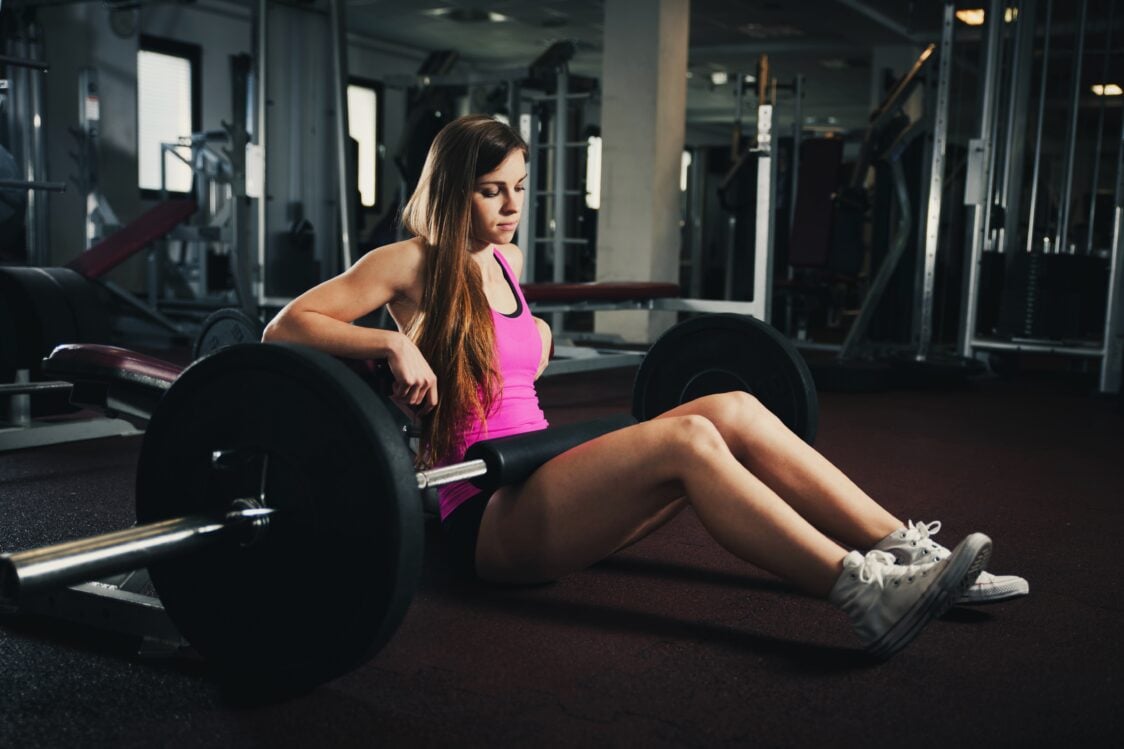
2. Execution
- Engage your core to help protect your hips from overloading.
- Exhale and slowly lift your pelvis upwards, focusing on contracting your gluteal muscles.
- Press your feet into the ground for better stability and increased activation of the glutes. [3]
- Lift your pelvis to a height where your body aligns parallel to the floor. In this position, your thighs and shins should form a 90° angle. Your pelvis is slightly tucked, which also helps activate the gluteal muscles while protecting the lower back.
- In the upper position, perform a 1-2 second hold with a maximal contraction of the gluteal muscles.
- Inhale and lower your pelvis down in a controlled manner.
- In the bottom position, lightly touch the floor with your buttocks and then proceed with the next repetition.
3. What are the most common mistakes when performing hip thrusts?
- Limited range of motion.
- Insufficient activation of the gluteal muscles and core.
- Excessive arching of the lower back (lifting the pelvis too high).
- Uncontrolled movement.
- Feet too far away from the hips.
- Bending the neck.
- Poorly chosen weight when doing hip thrusts with resistance.
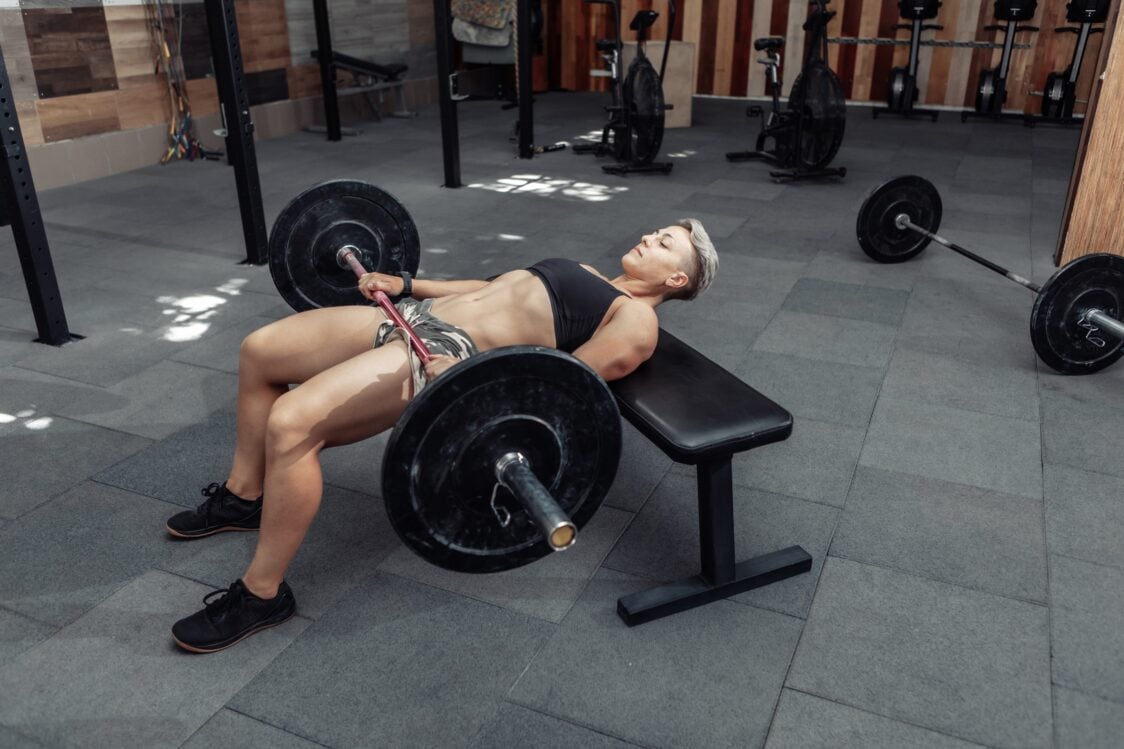
Hip Thrusts as Part of the Training Plan
Including hip thrusts in every workout probably isn’t the best idea. You might overstrain not only your gluteal muscles but also your hips. However, doing them just once a month likely won’t yield any results. Therefore, it’s crucial to find a middle ground and sensibly incorporate this exercise into your training plan.
- In a glute-focused training plan, it’s best to incorporate hip thrusts 1 to 2 times per week.
- For bodyweight hip thrusts, you can include them up to 3 times per week.
- The number of sets ranges from 3 to 6 depending on the weight load and other exercises in the workout.
- Include a rest period of 30 to 90 seconds between sets.
- If your goal is to increase strength, and you’re lifting weights slightly below your maximum (80 to 95%), extend your rest period to up to 4 minutes.
- The number of repetitions for the basic variation without added weight is 15 to 20.
- Perform variations with added weight in repetitions of 8 to 15.
- For strength-focused training with heavy weights, aim for 2 to 6 repetitions.
If you’re interested in learning about other exercises that can help strengthen and shape your glutes and thighs, check out the article: 9 Best Glutes & Legs Exercises.
How to do hip thrusts for advanced individuals?
If you can easily perform 15 to 20 repetitions without feeling muscle fatigue, you probably need to give your muscles a new stimulus for further growth and strengthening. These training tips might help you in that:
- Load a heavier weight onto the barbell, or use a heavier kettlebell or dumbbell.
- Gradually reduce the length of the rest period between exercises by 10 seconds.
- Incorporate supersets, during which you perform 2 or more variations of this exercise in a row without rest. For example, after a set with a kettlebell, immediately follow with a set using your own body weight.
Are you interested in getting a good workout at home without any equipment? Then you shouldn’t miss our article: How to Make Your Home Workout More Challenging Even Without Fitness Accessories
Discover our bestsellers:
6 Effective Variations of the Hip Thrust
The first step to mastering this exercise is learning the correct technique with your own body weight. All you need for that is a flat bench, a smaller box, or even a couch you have at home. Once you’ve mastered the basic variation, you can add resistance using a resistance band or weights such as a barbell, dumbbell, kettlebell, or even a power bag. Some gyms also have machines specifically for hip thrusts, often referred to as booty builders. These machines guide your movement, so they’re not as demanding in terms of technique, but it’s important to choose the right amount of resistance.
If you’re planning to incorporate weighted hip thrusts in your workout, don’t forget to properly warm up and mobilize your body beforehand. After a few minutes of warm-up (such as using an air bike, brisk walking on a treadmill, or skipping rope), focus on mobilizing the joints of your entire body, especially your hips, knees, and ankles. Afterwards, perform around 2 sets of hip thrusts with your body weight to activate your gluteal muscles. Only after that should you move on to using weights, which you can gradually increase over time.
1. Bodyweight Hip Thrust
- Starting Position: Sit on the floor with your upper back against a bench, keeping your head aligned with your spine. Bend your arms at the elbows, placing them on the bench behind you, and place your hands on your hips. Pull your feet towards your hips, keeping your entire foot or just your heels on the ground throughout the exercise. Your feet should be approximately shoulder-width apart, and your knees should be slightly turned outwards.
- Execution: Activate your core. Exhale and use your gluteal muscles to lift your pelvis upwards in a controlled manner until your torso is parallel to the ground. At the top position, focus on contracting your gluteal muscles. Hold for a second or two, then slowly lower your pelvis down in a controlled manner. Follow up with the next repetition.
- Common Mistakes: Arching the lower back in the top position, bending the neck, uncontrolled movement, improper foot positioning, limited range of motion.
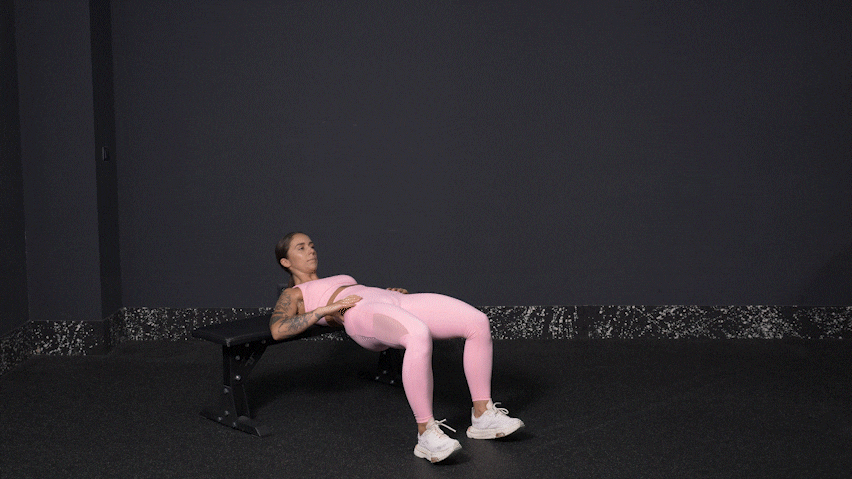
2. Single Leg Hip Thrust
- Starting Position: Sit on the ground with your upper back against a bench, keeping your head in line with your spine. Bend your arms at the elbows and rest them on the bench, placing your hands on your hips. Bring your heels close to your hips and position them next to each other. Keep one foot flat on the ground while lifting the other a few centimetres above the floor.
- Execution: Activate your core. Exhale and, by engaging your gluteal muscles, lift your pelvis and simultaneously lift your bent leg. At the top position, when your torso is parallel to the ground, perform a 1 to 2 second hold while actively contracting your glutes. Then, lower your pelvis down in a controlled manner and immediately continue with another repetition using the same leg. After completing the set, switch legs.
- Common Mistakes: Arching the lower back in the top position, bending the neck, uncontrolled movement, improper foot positioning, limited range of motion.
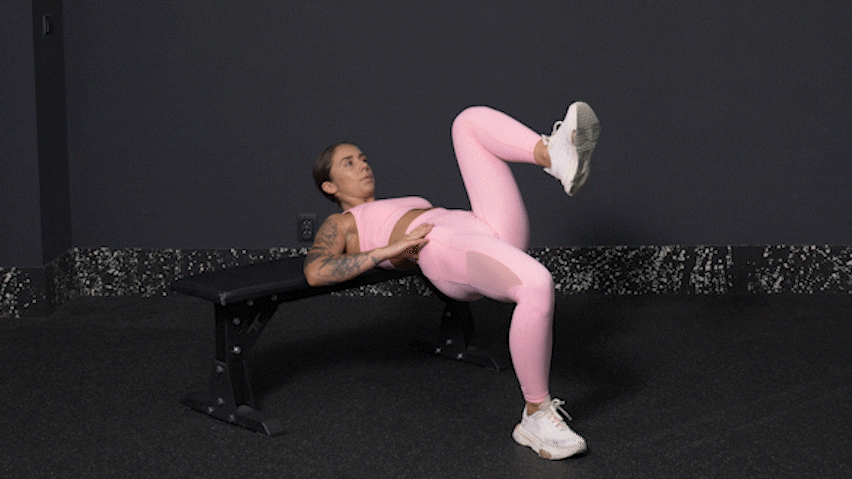
Another variation of the exercise:
1. Kettlebell Single Leg Hip Thrust
You can make this exercise more challenging by adding weight in the form of a kettlebell. Place it on your hips on the side of the supporting leg and hold onto the handle with both hands. Then, perform the exercise as you would with the bodyweight variation.
3. Barbell Hip Thrust
- Starting Position: Sit on the ground with your upper back against a bench, keeping your head in line with your spine. Place a barbell, either empty or loaded, on your hips. Bring your feet towards your hips and let them rest flat on the ground, either fully or just your heels. Spread them approximately shoulder-width apart and angle your knees slightly outwards.
- Execution: Activate your core. Exhale and engage your glutes to lift your hips with the barbell up in a controlled manner until your torso is parallel to the ground. Focus on contracting your glutes at the top position for a second or two. Then, lower your hips down in a controlled manner. Follow up with the next repetition.
- Common Mistakes: Arching the lower back in the top position, bending the neck, uncontrolled movement, improper foot positioning, limited range of motion, inappropriate weight selection.
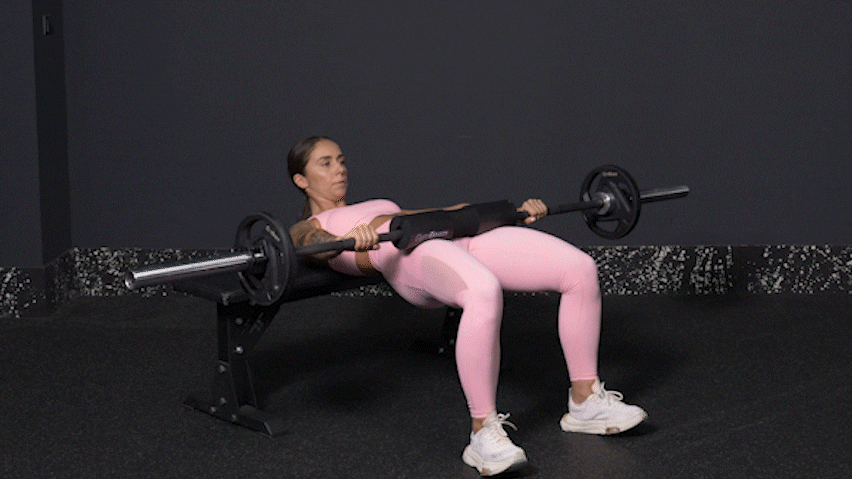
4. Kettlebell Hip Thrust
- Starting Position: Sit on the ground with your upper back against a bench, keeping your head in line with your spine. Place a kettlebell approximately in the centre between your pelvic bones. Bring your feet towards your hips and rest them flat on the ground or just the heels. Position your feet about shoulder-width apart and point your knees slightly outwards.
- Execution: Activate your core. Exhale and use your gluteal muscles to lift your hips with the kettlebell in a controlled manner until your torso is parallel to the ground. In the top position, focus on contracting your glutes. Hold for a second or two, then slowly lower your hips back down in a controlled manner. Follow up with the next repetition.
- Common Mistakes: Arching the lower back in the top position, bending the neck, uncontrolled movement, improper foot positioning, limited range of motion, inappropriate weight selection.
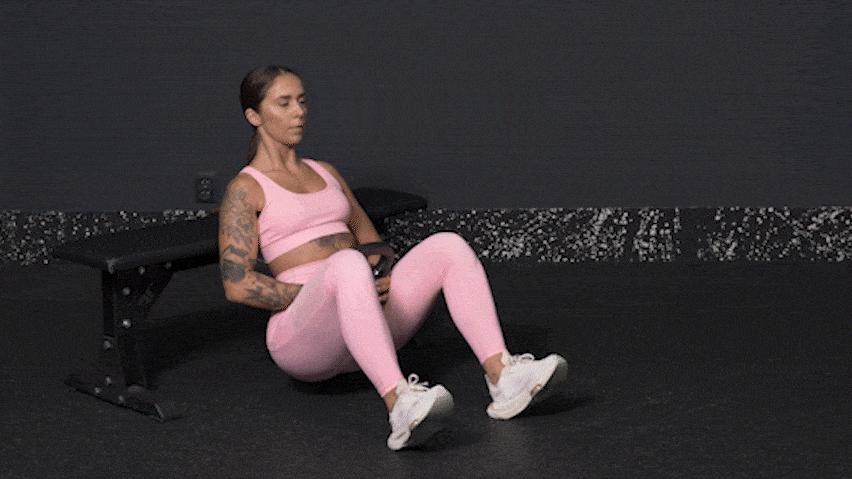
5. Dumbbell Hip Thrust
- Starting Position: Sit on the ground with your upper back against a bench, keeping your head in line with your spine. Place a dumbbell on your hip and grip it with both hands from the sides. Bring your feet towards your hips and place them flat on the ground, either fully or just your heels. Spread them approximately shoulder-width apart and angle your knees slightly outwards.
- Execution: Activate your core. Exhale and use your gluteal muscles to lift your hips with the dumbbell in a controlled manner until your torso is parallel to the ground. In the top position, focus on contracting your gluteal muscles. Hold for a second or two, then lower your hips down in a controlled manner. Follow up with the next repetition.
- Common Mistakes: Arching the lower back in the top position, bending the neck, uncontrolled movement, improper foot positioning, limited range of motion, inappropriate weight selection.
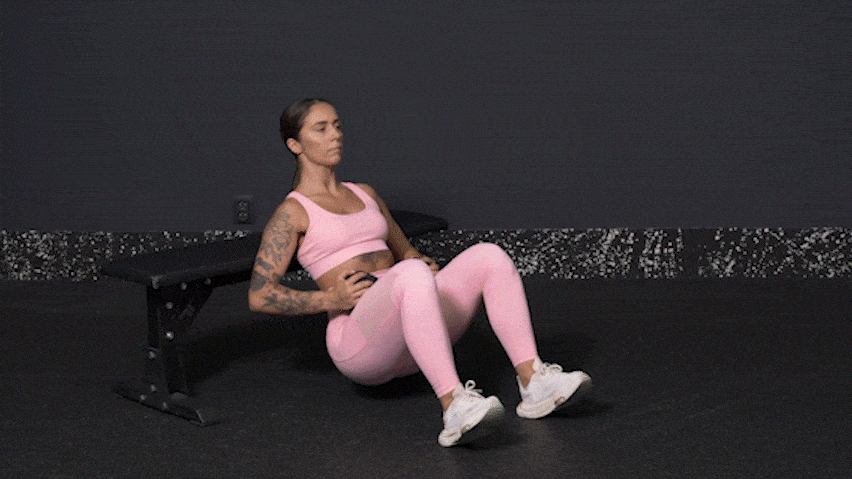
6. Resistance Band Hip Thrust
- Starting Position: Sit on the ground with your upper back against a bench and keep your head aligned with your spine. Then place a loop band above your knees. Bring your feet towards your hips and let them rest flat on the ground, either fully or just your heels. Spread them approximately shoulder-width apart and angle your knees slightly outwards.
- Execution: Activate your core. Exhale and use your gluteal muscles to lift your hips with the dumbbell in a controlled manner until your torso is parallel to the ground. In the top position, focus on contracting your gluteal muscles. Hold for a second or two, then lower your hips down in a controlled manner. Follow up with the next repetition.
- Common Mistakes: Arching the lower back in the top position, bending the neck, uncontrolled movement, improper foot positioning, limited range of motion, inappropriate weight selection.
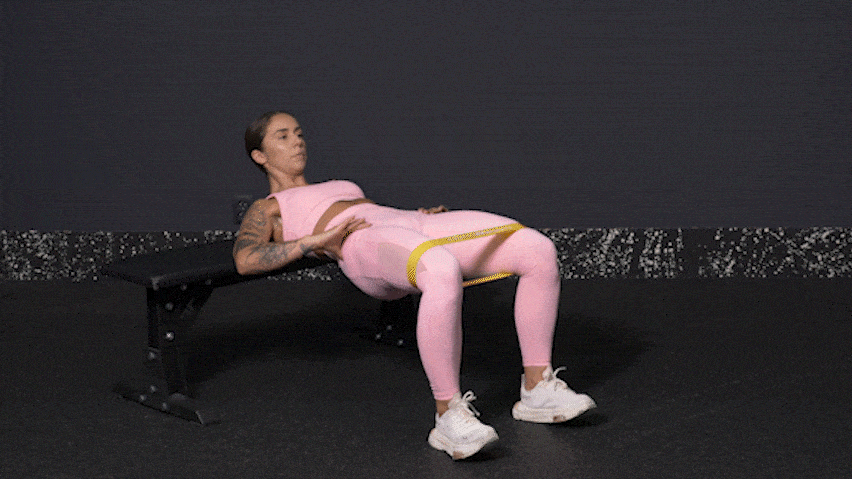
Where to Go From Here?
- You can find glute exercises without weights in the article: Get a Firm and Round Butt Without a Barbell. Try Resistance Band Workout
- You can also exercise with your own body weight according to the article: How to Work on Your Booty? Best Bodyweight Exercises for Round and Firm Glutes
- Do you have access to a kettlebell? If so, you can incorporate additional lower body exercises into your workout routine according to the article: 8 Best Booty & Leg Exercises With Kettlebell
- If you’ve been working on your glutes for a while and are unsure if you’re making any mistakes, the article “Myths About Glute Exercises That Stand Between You and a Stronger, Rounder and Firmer Butt” might help you.
- Want to work out your glutes in the comfort of your home? Then try the workout from the article: Leg & Butt Workout at Home: 14 Effective Bodyweight Exercises
- The article “How Much Weight to Lift for Muscle Growth, Strength or Weight Loss?” can help you with selecting the appropriate weights.
What Are the Main Takeaways?
The hip thrust is an effective exercise for strengthening the gluteal muscles and developing a rounded butt. In addition to enhancing aesthetic curves, it can contribute to improved performance in sprinting and everyday movement. This exercise can therefore benefit strength athletes as well as soccer players, basketball players, or sprinters.
First and foremost, it is crucial to master the proper technique and then gradually increase the weight load to maximize benefits. Incorporate heavy hip thrusts into your training routine 1 to 2 times per week. However, when you are using just your bodyweight, you can include this exercise more frequently, even before every lower body workout as an activation exercise. Make sure to always prioritize adequate recovery and complement your results with quality nutrition.
Did you find this article helpful? If so, share it with your friends and pass on tips for variations of the hip thrust exercise.
[1] Williams, I. Why You Need To Do More Barbell Hip Thrusts. – https://mensfitnesstoday.com/features/barbell-hip-thrust-benefits/
[2] Contreras, B. How to Hip Thrust. – https://bretcontreras.com/how-to-hip-thrust/
[3] Contreras, B. 10 Steps to the Perfect Hip Thrust. – https://bretcontreras.com/10-steps-to-the-perfect-hip-thrust/
[4] PureGym. How to do Hip Thrusts. – https://www.puregym.com/exercises/glutes/hip-thrusts/
[5] Glutes hypertrophy: Hip thrust or parallel squat? – https://www.sci-sport.com/en/articles/Glutes-hypertrophy-Hip-thrust-or-parallel-squat-239.php
[6] Neto, W. K., Vieira, T. L., & Gama, E. F. Barbell Hip Thrust, Muscular Activation and Performance: A Systematic Review. – https://www.ncbi.nlm.nih.gov/pmc/articles/PMC6544005/
[7] Lanza, M. B., Arbuco, B., Ryan, A. S., Shipper, A. G., Gray, V. L., & Addison, O. Systematic Review of the Importance of Hip Muscle Strength, Activation, and Structure in Balance and Mobility Tasks. – https://doi.org/10.1016/j.apmr.2021.12.008
[8] Hardingham, C. How to hip thrust correctly. – https://injuryactive.com/how-to-hip-thrust-correctly/


Add a comment